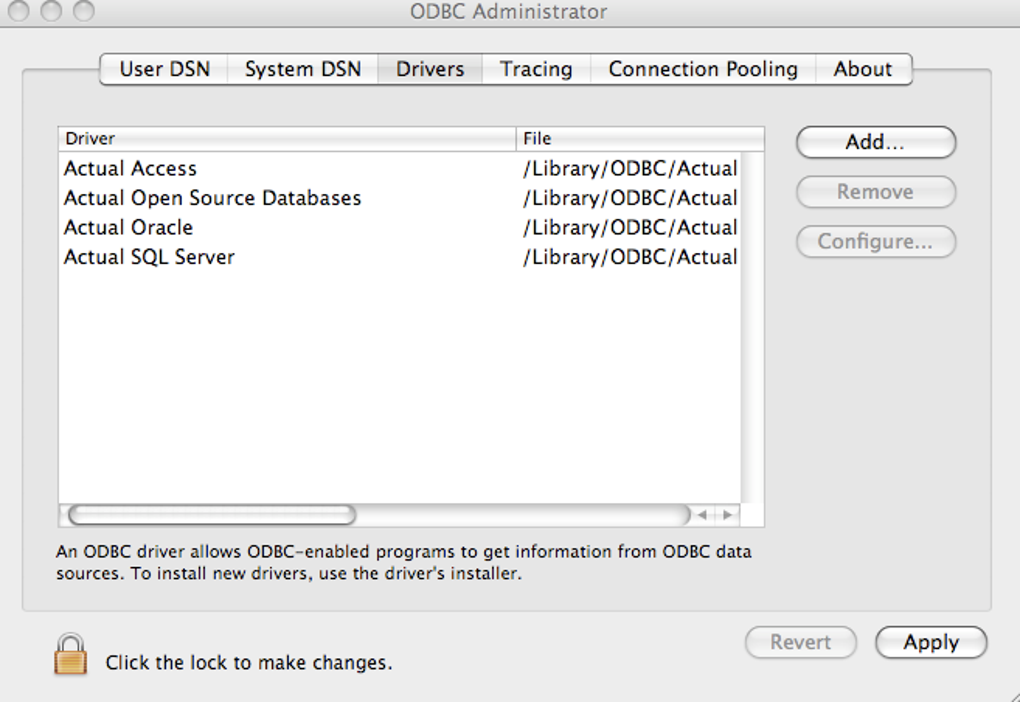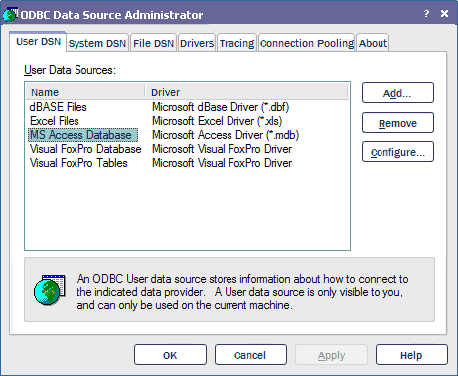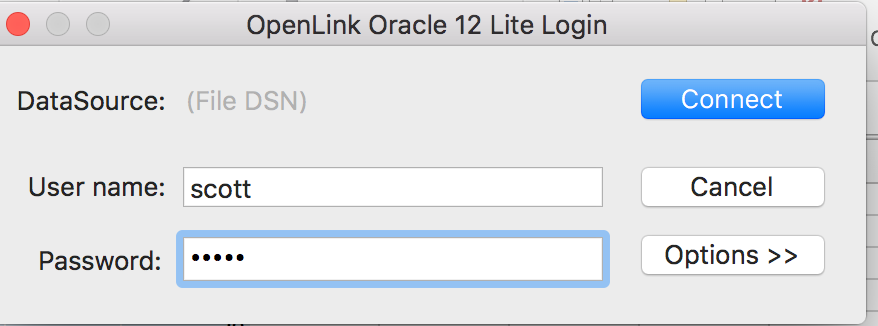- Vistadb Odbc Drivers For Mac Windows 7
- Vistadb Odbc Drivers For Mac Catalina
- Vistadb Odbc Drivers For Mac Os
- Vistadb Odbc Drivers For Mac
- Vistadb Odbc Drivers For Mac Windows 10
For correct operation of ODBC Administrator, ensure that the /Library/ODBC/odbc.ini file used to set up ODBC connectivity and DSNs are writable by the admin group. If this file is not writable by this group, then the ODBC Administrator may fail, or may appear to work but not generate the correct entry. ODBC Manager is a replacement for Apple's ODBC administrator utility, which is no longer included with Mac OS X (starting with Snow Leopard). ODBC Manager also addresses some of the problems and annoyances of Apple's administrator, including the use of underscores in names and keywords. Office 2016 for Mac comes with one ODBC driver for Microsoft SQL Server. It's installed with Office and it's always available on the Data tab of the Ribbon New Database Query SQL Server ODBC. If you want to connect to any other ODBC data source, such as an Excel Workbook, an Access Database, Oracle, etc you need a 3rd party ODBC driver. Download the Mac OSX ODBC Driver. Download the 64-bit Mac OSX ODBC driver, available on the ODBC Driver for Mac OSX tool page. Follow the installation instructions. Open the mlsqlodbc.dmg file, and the subsequent.pkg file. This is the MarkLogic ODBC Installer. Follow the installation instructions. Install in default location. The ODBC configuration files are located in /Library/ODBC within your home directory. There is an odbcinst.ini file for driver information and an odbc.ini file for data source information. You can also use the Data Source utility (dbdsn) to create ODBC data sources on Mac OS X. See Data Source utility (dbdsn). To create an ODBC data source.
The ODBC drivers for Linux and macOS support AlwaysOn Availability Groups. For more information about AlwaysOn Availability Groups, see:
You can specify the availability group listener of a given availability group in the connection string. If an ODBC application on Linux or macOS is connected to a database in an availability group that fails over, the original connection is broken and the application must open a new connection to continue work after the failover.
The ODBC drivers on Linux and macOS iterate sequentially through all IP addresses associated with a DNS hostname if you are not connecting to an availability group listener, and multiple IP addresses are associated with the hostname.

If the DNS server's first returned IP address is not connectable, these iterations can be time consuming. When connecting to an availability group listener, the driver attempts to establish connections to all IP addresses in parallel. If a connection attempt succeeds, the driver discards any pending connection attempts.
Note
Because a connection can fail due to an availability group failover, implement connection retry logic; retry a failed connection until it reconnects. Increasing connection timeout and implementing connection retry logic increases the chance of connecting to an availability group.

Connecting With MultiSubnetFailover
Always specify MultiSubnetFailover=Yes when connecting to a SQL Server 2012 (11.x) availability group listener or SQL Server 2012 (11.x) Failover Cluster Instance. MultiSubnetFailover enables faster failover for all Availability Groups and failover cluster instance in SQL Server 2012 (11.x). MultiSubnetFailover also significantly reduces failover time for single and multi-subnet AlwaysOn topologies. During a multisubnet failover, the client attempts connections in parallel. During a subnet failover, the driver aggressively retries the TCP connection.
The MultiSubnetFailover connection property indicates that the application is being deployed in an availability group or Failover Cluster Instance. The driver tries to connect to the database on the primary SQL Server instance by trying to connect to all the IP addresses. When connecting with MultiSubnetFailover=Yes, the client retries TCP connection attempts faster than the operating system's default TCP retransmit intervals. MultiSubnetFailover=Yes enables faster reconnection after failover of either an AlwaysOn Availability Group or an AlwaysOn Failover Cluster Instance. MultiSubnetFailover=Yes applies to both single- and multi-subnet Availability Groups and Failover Cluster Instances.
Use MultiSubnetFailover=Yes when connecting to an availability group listener or Failover Cluster Instance. Otherwise, your application's performance can be negatively affected.
Note the following when connecting to a server in an availability group or Failover Cluster Instance:
Specify MultiSubnetFailover=Yes to improve performance when connecting to a single subnet or multi-subnet Availability Group.
Specify the availability group listener of the availability group as the server in your connection string.
You cannot connect to a SQL Server instance configured with more than 64 IP addresses.
Both SQL Server Authentication or Kerberos Authentication can be used with MultiSubnetFailover=Yes without affecting the behavior of the application.
You can increase the value of loginTimeout to accommodate for failover time and reduce the application's connection retry attempts.
Distributed transactions are not supported.
If read-only routing is not in effect, connecting to a secondary replica location in an availability group fails in the following situations:
If the secondary replica location is not configured to accept connections.
If an application uses ApplicationIntent=ReadWrite and the secondary replica location is configured for read-only access.
A connection fails if a primary replica is configured to reject read-only workloads and the connection string contains ApplicationIntent=ReadOnly.
Specifying Application Intent

The keyword ApplicationIntent can be specified in your connection string. The assignable values are ReadWrite or ReadOnly. The default is ReadWrite.
When ApplicationIntent=ReadOnly, the client requests a read workload when connecting. The server enforces the intent at connection time, and during a USE database statement.
The ApplicationIntent keyword does not work with legacy read-only databases.
Targets of ReadOnly
When a connection chooses ReadOnly, the connection is assigned to any of the following special configurations that might exist for the database:
- A database can allow or disallow read workloads on the targeted Always On database. This choice is controlled by using the ALLOW_CONNECTIONS clause of the PRIMARY_ROLE and SECONDARY_ROLE Transact-SQL statements.
If none of those special targets are available, the regular database is read from.
The ApplicationIntent keyword enables read-only routing.
Read-Only Routing
Read-only routing is a feature that can ensure the availability of a read-only replica of a database. To enable read-only routing, all of the following apply:
You must connect to an Always On Availability Group availability group listener.
The ApplicationIntent connection string keyword must be set to ReadOnly.
The Availability Group must be configured by the database administrator to enable read-only routing.
Multiple connections each using read-only routing might not all connect to the same read-only replica. Changes in database synchronization or changes in the server's routing configuration can result in client connections to different read-only replicas. You can ensure that all read-only requests connect to the same read-only replica. Ensure this sameness by not passing an availability group listener to the Server connection string keyword. Instead, specify the name of the read-only instance.
Read-only routing may take longer than connecting to the primary. The longer wait is because read-only routing first connects to the primary, and then looks for the best available readable secondary. Due to these multiple steps, you should increase your login timeout to at least 30 seconds.
ODBC Syntax
Two ODBC connection string keywords support AlwaysOn Availability Groups:
Vistadb Odbc Drivers For Mac Windows 7
ApplicationIntent
MultiSubnetFailover
For more information about ODBC connection string keywords, see Using Connection String Keywords with SQL Server Native Client.
The equivalent connection attributes are:
SQL_COPT_SS_APPLICATION_INTENT
SQL_COPT_SS_MULTISUBNET_FAILOVER
For more information about ODBC connection attributes, see SQLSetConnectAttr.
Vistadb Odbc Drivers For Mac Catalina
An ODBC application that uses AlwaysOn Availability Groups can use one of two functions to make the connection:
| Function | Description |
|---|---|
| SQLConnect Function | SQLConnect supports both ApplicationIntent and MultiSubnetFailover via a data source name (DSN) or connection attribute. |
| SQLDriverConnect Function | SQLDriverConnect supports ApplicationIntent and MultiSubnetFailover via DSN, connection string keyword, or connection attribute. |
See Also
Using VistaDB with ODBC and OleDB Print
Modified on: Tue, Jul 22, 2014 at 12:22 AM
Question
Vistadb Odbc Drivers For Mac Os
Can I access a VistaDB database via ODBC or OleDB?
Vistadb Odbc Drivers For Mac
Answer
Vistadb Odbc Drivers For Mac Windows 10
VistaDB is written entirely for .NET and supports the .NET standard data access API - ADO.NET. Unfortunately, ODBC and OleDB are unmanaged API's that rely on raw buffer access and other things not available in .NET. Therefore, VistaDB has no providers for ODBC or OleDB.
It is theoretically possible to write an adapter in C or C++ between ODBC/OleDB and ADO.NET however it would be inefficient due to the extensive translations back and forth between managed and unmanaged code.
Many applications that support ODBC/OleDB for database access also support ADO.NET. If that option is available you should be able to use it by registering VistaDB as an ADO.NET provider for the current process. For details on how to register VistaDB as an ADO.NET provider, see Deploying VistaDB with your Application.
